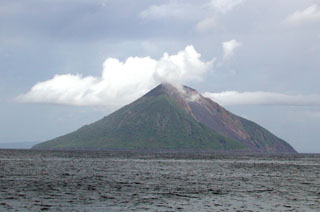Report on Tinakula (Solomon Islands) — 15 February-21 February 2012
Smithsonian Institution / US Geological Survey
Weekly Volcanic Activity Report, 15 February-21 February 2012
Managing Editor: Sally Sennert.
Please cite this report as:
Global Volcanism Program, 2012. Report on Tinakula (Solomon Islands) (Sennert, S, ed.). Weekly Volcanic Activity Report, 15 February-21 February 2012. Smithsonian Institution and US Geological Survey.
Tinakula
Solomon Islands
10.386°S, 165.804°E; summit elev. 796 m
All times are local (unless otherwise noted)
According to NASA's Earth Observatory, thermal anomalies from Tinakula were detected in satellite data during 13-14 February and a gas plume with possible ash content rose from the volcano on 14 February.
Geological Summary. The small 3.5-km-wide island of Tinakula is the exposed summit of a massive stratovolcano at the NW end of the Santa Cruz islands. It has a breached summit crater that extends from the summit to below sea level. Landslides enlarged this scarp in 1965, creating an embayment on the NW coast. The Mendana cone is located on the SE side. The dominantly andesitic volcano has frequently been observed in eruption since the era of Spanish exploration began in 1595. In about 1840, an explosive eruption apparently produced pyroclastic flows that swept all sides of the island, killing its inhabitants. Recorded eruptions have frequently originated from a cone constructed within the large breached crater. These have left the upper flanks and the steep apron of lava flows and volcaniclastic debris within the breach unvegetated.
Source: NASA Earth Observatory

